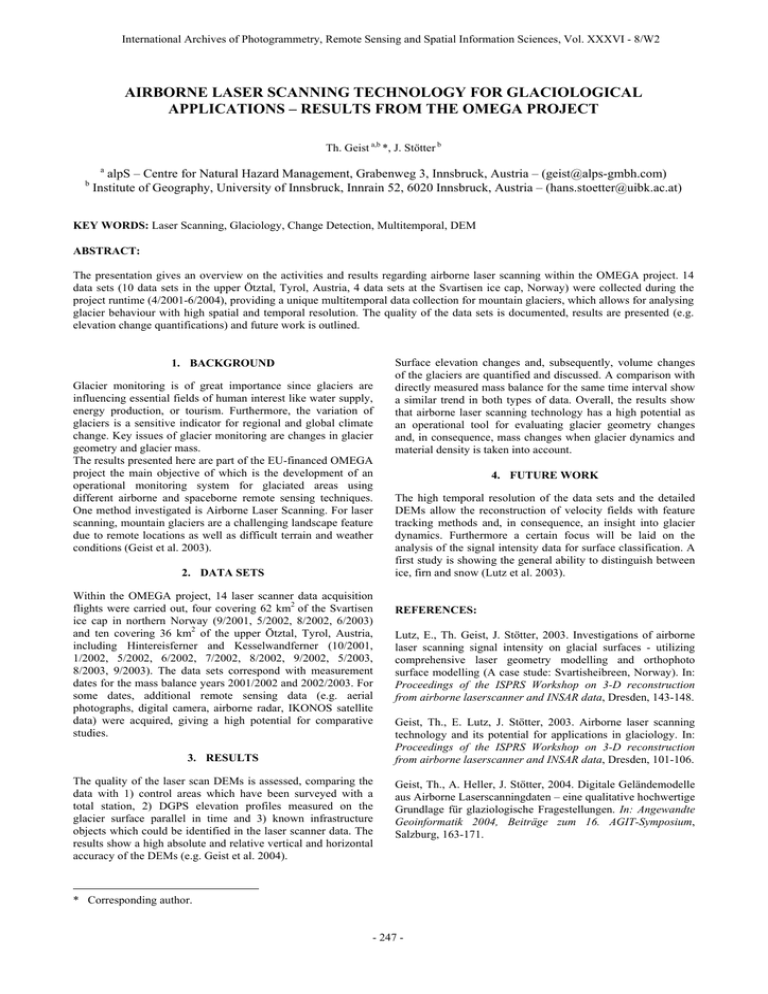AIRBORNE LASER SCANNING TECHNOLOGY FOR GLACIOLOGICAL
advertisement

International Archives of Photogrammetry, Remote Sensing and Spatial Information Sciences, Vol. XXXVI - 8/W2 AIRBORNE LASER SCANNING TECHNOLOGY FOR GLACIOLOGICAL APPLICATIONS – RESULTS FROM THE OMEGA PROJECT Th. Geist a,b *, J. Stötter b a b alpS – Centre for Natural Hazard Management, Grabenweg 3, Innsbruck, Austria – (geist@alps-gmbh.com) Institute of Geography, University of Innsbruck, Innrain 52, 6020 Innsbruck, Austria – (hans.stoetter@uibk.ac.at) KEY WORDS: Laser Scanning, Glaciology, Change Detection, Multitemporal, DEM ABSTRACT: The presentation gives an overview on the activities and results regarding airborne laser scanning within the OMEGA project. 14 data sets (10 data sets in the upper Ötztal, Tyrol, Austria, 4 data sets at the Svartisen ice cap, Norway) were collected during the project runtime (4/2001-6/2004), providing a unique multitemporal data collection for mountain glaciers, which allows for analysing glacier behaviour with high spatial and temporal resolution. The quality of the data sets is documented, results are presented (e.g. elevation change quantifications) and future work is outlined. 1. BACKGROUND Glacier monitoring is of great importance since glaciers are influencing essential fields of human interest like water supply, energy production, or tourism. Furthermore, the variation of glaciers is a sensitive indicator for regional and global climate change. Key issues of glacier monitoring are changes in glacier geometry and glacier mass. The results presented here are part of the EU-financed OMEGA project the main objective of which is the development of an operational monitoring system for glaciated areas using different airborne and spaceborne remote sensing techniques. One method investigated is Airborne Laser Scanning. For laser scanning, mountain glaciers are a challenging landscape feature due to remote locations as well as difficult terrain and weather conditions (Geist et al. 2003). 2. DATA SETS Within the OMEGA project, 14 laser scanner data acquisition flights were carried out, four covering 62 km2 of the Svartisen ice cap in northern Norway (9/2001, 5/2002, 8/2002, 6/2003) and ten covering 36 km2 of the upper Ötztal, Tyrol, Austria, including Hintereisferner and Kesselwandferner (10/2001, 1/2002, 5/2002, 6/2002, 7/2002, 8/2002, 9/2002, 5/2003, 8/2003, 9/2003). The data sets correspond with measurement dates for the mass balance years 2001/2002 and 2002/2003. For some dates, additional remote sensing data (e.g. aerial photographs, digital camera, airborne radar, IKONOS satellite data) were acquired, giving a high potential for comparative studies. 3. RESULTS The quality of the laser scan DEMs is assessed, comparing the data with 1) control areas which have been surveyed with a total station, 2) DGPS elevation profiles measured on the glacier surface parallel in time and 3) known infrastructure objects which could be identified in the laser scanner data. The results show a high absolute and relative vertical and horizontal accuracy of the DEMs (e.g. Geist et al. 2004). Surface elevation changes and, subsequently, volume changes of the glaciers are quantified and discussed. A comparison with directly measured mass balance for the same time interval show a similar trend in both types of data. Overall, the results show that airborne laser scanning technology has a high potential as an operational tool for evaluating glacier geometry changes and, in consequence, mass changes when glacier dynamics and material density is taken into account. 4. FUTURE WORK The high temporal resolution of the data sets and the detailed DEMs allow the reconstruction of velocity fields with feature tracking methods and, in consequence, an insight into glacier dynamics. Furthermore a certain focus will be laid on the analysis of the signal intensity data for surface classification. A first study is showing the general ability to distinguish between ice, firn and snow (Lutz et al. 2003). REFERENCES: Lutz, E., Th. Geist, J. Stötter, 2003. Investigations of airborne laser scanning signal intensity on glacial surfaces - utilizing comprehensive laser geometry modelling and orthophoto surface modelling (A case stude: Svartisheibreen, Norway). In: Proceedings of the ISPRS Workshop on 3-D reconstruction from airborne laserscanner and INSAR data, Dresden, 143-148. Geist, Th., E. Lutz, J. Stötter, 2003. Airborne laser scanning technology and its potential for applications in glaciology. In: Proceedings of the ISPRS Workshop on 3-D reconstruction from airborne laserscanner and INSAR data, Dresden, 101-106. Geist, Th., A. Heller, J. Stötter, 2004. Digitale Geländemodelle aus Airborne Laserscanningdaten – eine qualitative hochwertige Grundlage für glaziologische Fragestellungen. In: Angewandte Geoinformatik 2004, Beiträge zum 16. AGIT-Symposium, Salzburg, 163-171. * Corresponding author. - 247 -





